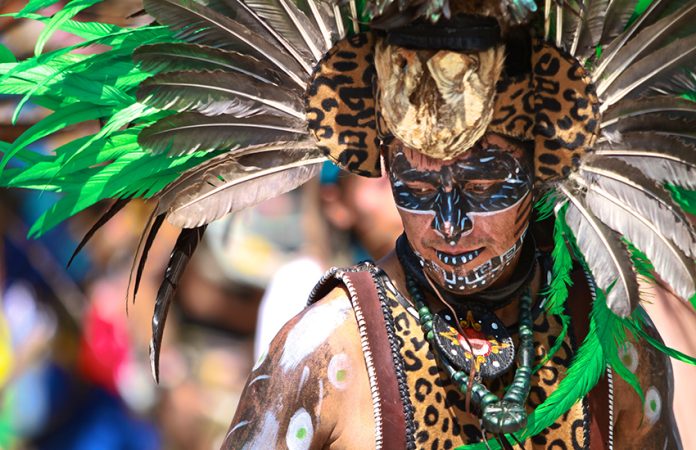I admit it: I got completely captivated by this story about Cuauhtémoc’s final resting place, prompting a visit to Ixcateopan, an isolated town near Taxco, Guerrero. I later wrote about it in Wikipedia using municipality publications.
Only later, after an online scolding by a Mexican Wikipedian, did I look at the story more critically and found that its authenticity is unclear.
You have probably seen the name Cuauhtémoc on many streets in Mexico. His name is better remembered here than that of Montezuma/Moctezuma, although both saw the demise of the Aztecs. In Mexico, Moctezuma is blamed for conquistador Hernán Cortés’ triumph while Cuauhtémoc is seen as the tragic symbol of the Mesoamerican world’s loss.
According to documents promoted by authorities in the state of Guerrero and the municipality of Ixcateopan, Cuauhtémoc was born on February 23, 1504 (some say 1500), in rural Guerrero, the son of Prince Ahuizotl and Princess Cuayutital.
He began his career in the court of Tenochtitlán (Mexico City) in 1516, eventually becoming a warrior tasked with the defense of the empire against the Spanish. Moctezuma was killed by his own people, and his successor, Cuitláhuac, died after a few months of smallpox, leaving Cuauhtémoc as ruler. The young king was defeated in August 1521 by Cortés and executed a few years later.

On September 26, 1949, a historian named Eulalia Guzmán and the painter Diego Rivera announced the discovery of Cuauhtémoc’s remains underneath the parish church of Ixcateopan.
The church lay next to an archaeological site and, very probably, atop a pre-Hispanic cemetery. The historian stated that she had found documentation indicating the Cuauhtémoc was buried there and so set up an excavation, which reported finding a pit carefully covered over in the local rock.
Under that were two copper plaques, one with a cross and the inscription 1,525 1,529, Rey, é, S, Coatemo (supposedly a variation on Cuauhtémoc’s name). Underneath these was a copper spear, along with human bone fragments and various grave goods.
Rivera was brought in to arrange the bone fragments in human form as well as to publicize the find. As the country’s most famous painter of indigenous life before the Conquest, his word would have great weight in the popular imagination. And it certainly did.
The find has been controversial ever since, generally pitting established academia against local authorities and indigenous activists.
Those who believe the remains to be genuinely those of Cuauhtémoc point to several 16th-century writings and a coat of arms on the church with indigenous symbols, as well as local oral history and traditions.
The story they promote is that Cuauhtémoc was killed in Tabasco on February 28, 1525. Loyalists later carried him for over a week to Ixcateopan, where he was buried secretly. The body was later moved to where the parish church was built, and the coat of arms remains as a testament.
Guzmán quickly convinced local and state authorities of the authenticity of the find. They renamed the town Ixcateopan de Cuauhtémoc in 1950. However, the feds were not so easily convinced.
The National Institute of Anthropology and History (INAH) formed a commission in 1949 that determined the remains were not those of Cuauhtémoc. However, not all commission members agreed.
The issue was taken up again in 1976, but the experts not only confirmed that the remains were not of the emperor but that they are of eight different people who died at different time periods. They also made accusations that the original discovery had been manipulated by people with political and economic agendas.
Despite this, INAH refused to close the case definitively, citing the intense public interest in the matter. Since then, academic publications generally reassert the 1976 findings and have even accused Guzmán of incompetence.
There are serious holes in the story, not only about Ixcateopan being Cuauhtemoc’s final resting place but also on it being his birthplace, which the town also claims. First, the story depends on Ixcateopan being important enough to produce someone who could ascend to the throne. Although there is an archaeological site, there is no evidence that the area was an important region in the Aztec Empire.

There are also serious questions about the accuracy of documents, especially those which are copies of earlier records. Lastly, the parish church was most likely built in the mid-16th century; the 1539 date on the coat-of-arms is considered a forgery.
None of this has deterred many state and local authorities, as well as people devoted to a particular idea of pre-Conquest Mexico. What we may be seeing in Ixcateopan is the rise of a mythology, not unlike the development of relics in medieval Europe.
To be perfectly blunt and cynical, if federal authorities had any inkling that the bones were really Cuauhtémoc’s, they would be in Mexico City, not Ixcateopan. The most ardent defenders of the bones’ authenticity are local and state officials and cultural activists.
Ixcateopan identifies itself as the “cradle of indigenousness,” with the main plaza named after Eulalia Guzmán. Pilgrimages to the shrine are important culturally and economically, especially on the anniversaries of Cuauhtémoc’s birth and death (February 23 and 28 respectively), when representatives from indigenous groups from all over North America come to pay respects. Tourism to Ixcateopan increased each year before the pandemic, and there is no reason to believe this will not continue after it is over.
In essence, it may not matter if the bones are scientifically proven to be those of Cuauhtémoc or not; it is hard not to feel like you are in the tlatoani’s presence while standing before the shrine.
They provide a psychological link to a long-gone world but one that is still important to many people’s identities.
Leigh Thelmadatter arrived in Mexico 18 years ago and fell in love with the land and the culture in particular its handcrafts and art. She is the author of Mexican Cartonería: Paper, Paste and Fiesta (Schiffer 2019). Her culture column appears regularly on Mexico News Daily.
